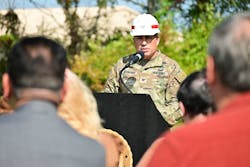Construction Begins on U.S. Army’s Latest Microgrid at Fort Campbell in Kentucky
Located on the Kentucky-Tennessee border, Fort Campbell is home to the Screaming Eagles of the Army’s 101st Airborne Division (Air Assault), the 5th Special Forces Group and the 160th Special Operations Aviation Regiment.
Soon, it will also be home to a microgrid powered by three 2-MW natural gas generators. A groundbreaking ceremony was held during the first week of October to kick off the Army’s Energy Action Month.
Helping the Military build Resilient and Sustainable Microgrids: Guest Post by Schneider Electric
The “groundbreaking signifies nearly a decade of committed research, planning and refining to define and develop a project scope that would … support vital resiliency and mission capacity objectives,” said Col. Chris Midberry, Fort Campbell garrison commander.
Energy security ensures military readiness
The theme for the Army’s Energy Action Month is “Readiness Through Resilience,” which emphasizes the critical link between the availability of reliable energy and the military’s ability to carry out its missions.
The Fort Campbell microgrid is yet another example of how the U.S. military is shoring up its resilience with energy security projects.
Last year, the Army announced it would build microgrids at each of its 130 bases worldwide by 2035. Other branches of the military have made similar commitments with microgrids installed or under construction at Marine Corps Air Station Miramar in California, as well as New Mexico’s Kirtland Air Force Base and White Sands Missile Range, among a growing list of other military facilities.
“Energy security is a fundamental aspect of national security, particularly for the Army. Uninterrupted power supply is essential for Army operations and is a key enabler of national defense,” said Robert Ott, energy manager, Directorate of Public Works (DPW) at Fort Campbell.
“This project delivers a buffer against cyberthreats, providing a resilient, reliable backup, while meeting cost savings and sustainability objectives,” added Midberry.
The Fort Campbell microgrid, which is expected to be completed in 2025, will allow the base to maintain 100% mission capability for up to two weeks in the event of a grid failure.
A multipronged approach
In addition to investing in resilience technologies such as microgrids, military leaders at Fort Campbell believe energy efficiency is key to being mission ready. They encourage those at the garrison to reduce their energy consumption at home, in the barracks and in offices.
“Residents can adopt various strategies to conserve both energy and water, contributing to environmental sustainability and cost savings,” said Mir Khan, an energy engineer at the DPW. “Fort Campbell's DPW conducts events and educational initiatives to raise awareness about conservation and energy-saving practices,” Khan added.
Learn more about the military’s microgrid commitments. Subscribe to the free Microgrid Knowledge Newsletter.








